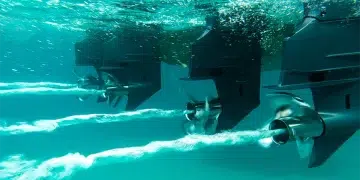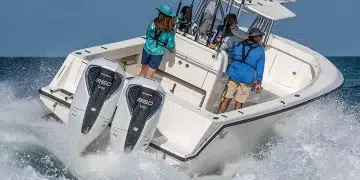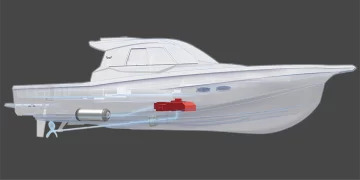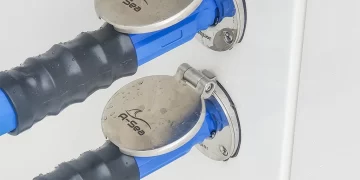Why Proper Shaft Alignment for Inboard Engines is Crucial

The importance of proper shaft alignment
The propeller shaft on an inboard engine isn’t one of those things you’d regularly look at when doing a maintenance check, but it warrants a periodic inspection, especially if you’ve bumped the bottom, struck some flotsam, or wrapped up a crab pot line. It definitely should be examined when the boat is out of the water; just a quick twist on the prop can speak volumes. “If your propeller and shaft require excessive effort to turn while the vessel is afloat or ashore, then it’s possible that a misalignment issue exists,” says Steve D’Antonio, founder and CEO of Steve D’Antonio Marine Consulting. Unless the yacht really slammed into something, it might be hard to tell if the shaft is out of alignment. “Contrary to popular belief, misalignment rarely causes vibration because the misalignment is constant,” he adds.
“Every hull responds differently to vibration,” says Rich Merhige, owner of Advanced Mechanical Enterprises. “If you have a very stiff, rigid hull, like a very strong, well-built boat, not a lightweight boat, then a bent shaft may not be obvious, but if you’re a high-speed, high-performance boat, a bent shaft would be really obvious.” He points out that a bent shaft won’t necessarily cause the structure of the hull to get excited by vibration. “You can have a heavy, well-built boat with a slow turning shaft, and you’ll never even know it’s bent,” he adds, “but it’ll still do damage.”
Subscribe Here For Weekly Updates
What Will Happen
“When the alignment is incorrect, a variety of undesirable events can occur, from excessive vibration and fuel consumption to transmission bearing and shaft failure,” explains D’Antonio in his blog. “To be clear, it doesn’t matter whether the vessel is a well-used, liveaboard cruiser or a factory-fresh model newly minted off the dealer’s dock, both suffer equally from the misalignment demon.”
Unchecked misalignment can cause major damage. “Critical components in the drive line, typically, are the shaft seal and the reduction gear,” says Merhige. “The reduction gear has precision metal bearings, and you’re essentially overloading those bearings. …Then you have the propeller shaft seal, the water seal that prevents water from coming in the boat, and when you have misalignment there, it puts wear and tear on the seal which could cause premature or catastrophic failure.”
There are two different points of alignment as it pertains to the shaft: engine alignment and shaft bearing alignment. “For engine alignment, assuming it is right from the factory and hasn’t been touched, per se, it can go out of alignment if motor mounts settle or collapse,” says D’Antonio. Logic dictates that whenever the shaft couplings are separated, alignment should be checked. “Shaft to bearing alignment should never change once set unless the vessel suffers damage, a grounding, for instance.”
In any case, misalignment can cause premature wear on the shaft bearings, aka cutlass bearings. The shaft could potentially bend, and the engine could suffer from a lack of performance, meaning the engine could bog down because energy is consumed by the misalignment instead of going to the propeller. That also leads to an increase in fuel consumption as well as accelerated bearing and shaft wear. Shaft bearings are tubular components with an inner liner. “It comes as a surprise to many users that the sole source of lubrication and cooling is seawater,” says D’Antonio. “If water flow to the bearing is insufficient or if it’s interrupted by marine growth on the shaft or clogging of a shaft log water injection system, rapid bearing wear can ensue.”
The shaft log is where the shaft passes through the hull and one location where a bearing is found. Depending on the shaft’s length, struts are attached to the hull to support it. Misalignment can also happen if the builder doesn’t properly align the shaft log and struts with the proposed shaft’s centerline in relation to the engine coupling. “If the builder is successful in ensuring this alignment, barring groundings or other damage, it should remain correct throughout the life of the vessel,” says D’Antonio.
What to Do
“If you hit bottom you have to assume the worst, and it’s really wise to do a vibration analysis or a very thorough inspection because you may not be aware of the damage you’ve done,” says Merhige. “I’ve seen boats that have barely touched and, unfortunately, it was the weight and the forces involved that generated some damage. It’s better to catch it sooner than later. You don’t want be in the middle of the Gulf Stream on your way to the Bahamas and have a propulsion failure.”
If you feel a vibration that you didn’t before, there are methods to check the alignment prior to hauling out. “We can do underway testing with vibration analysis, which will pick up a lot of defects that you may not be aware of,” says Merhige. “The vibration equipment is very sensitive, and it can pick up those frequencies that can be potentially damaging.” If detected, then it’s time to pull the boat out. After a check on the shaft’s straightness and balance and the use of lasers and specialized alignment tools to complete the process, there’s another step.
“While it’s possible to carry out a pre-alignment ashore, a final engine alignment must be carried out while a vessel is afloat, and in the case of fiberglass vessels and especially timber vessels, after it’s been floating for at least twelve hours,” says D’Antonio. “Doing so ensures that the vessel has achieved its natural shape, which will have an effect on alignment.”
Aligning a shaft is no easy task. “Misalignment is one of the most insidious maladies that can be visited upon your vessel,” adds D’Antonio. “Take no chances. Make sure yours is correct. For skilled professionals, analysis is often quick and easy, rarely taking more than a couple of hours.” If work needs to be done, avoid the stress and let the professionals do it.
-by Jeremy Peters
Related Posts
var jnews_module_54586_8_66fd9f74a1a3f = {“header_icon”:””,”first_title”:”Related”,”second_title”:” Posts”,”url”:””,”header_type”:”heading_6″,”header_background”:””,”header_secondary_background”:””,”header_text_color”:””,”header_line_color”:””,”header_accent_color”:””,”header_filter_category”:””,”header_filter_author”:””,”header_filter_tag”:””,”header_filter_text”:”All”,”sticky_post”:false,”post_type”:”post”,”content_type”:”all”,”sponsor”:false,”number_post”:{“unit”:”px”,”size”:6,”sizes”:[]},”post_offset”:0,”unique_content”:”disable”,”include_post”:””,”included_only”:false,”exclude_post”:54586,”include_category”:”6165,31576,31505,6166,6167″,”exclude_category”:””,”include_author”:””,”include_tag”:””,”exclude_tag”:””,”category”:””,”post_tag”:””,”jobpost_category”:””,”jobpost_job_type”:””,”jobpost_location”:””,”jobpost_tag”:””,”sort_by”:”latest”,”date_format”:”default”,”date_format_custom”:”Y/m/d”,”force_normal_image_load”:””,”pagination_mode”:”disable”,”pagination_nextprev_showtext”:””,”pagination_number_post”:{“unit”:”px”,”size”:6,”sizes”:[]},”pagination_scroll_limit”:{“unit”:”px”,”size”:3,”sizes”:[]},”boxed”:””,”boxed_shadow”:””,”el_id”:””,”el_class”:””,”scheme”:””,”column_width”:”auto”,”title_color”:””,”accent_color”:””,”alt_color”:””,”excerpt_color”:””,”css”:””,”excerpt_length”:{“unit”:”px”,”size”:20,”sizes”:[]},”paged”:1,”column_class”:”jeg_col_3o3″,”class”:”jnews_block_9″};
The post Why Proper Shaft Alignment for Inboard Engines is Crucial appeared first on Southern Boating.
Source: https://southernboating.com/engines/why-proper-shaft-alignment-for-inboard-engines-is-crucial/











